| Article ID | Journal | Published Year | Pages | File Type |
|---|---|---|---|---|
| 4734107 | Journal of Structural Geology | 2006 | 13 Pages |
Erta Ale volcano lies along the on-shore Red Sea Rift (northern Afar, Ethiopia), separating the Nubia and Danakil plates. Erta Ale has a NNW–SSE elongated caldera, with a subvertical rim scarp, hosting a lava lake. Structural field work was aimed at defining the deformation pattern around the caldera. The caldera consists of along-rim and across-rim structures, resulting from local and regional (maximum extension ∼NE–SW) stress fields, respectively. These structures cross-cut each other at high angles, suggesting that the two stress fields remain distinct, each prevailing during rifting or caldera collapse. The local along-rim extensional fractures are gravity-driven structures that formed due to the retreat of the caldera wall after collapse, and are confined to the region of caldera subsidence. The across-rim structures are mainly located to the N and S of the caldera, where they form rift zones each accommodating a similar amount of extension (∼6.3 m), but displaying different trends and extension directions. Analogue models of interacting fractures are consistent with the Southern Rift being representative of the regional fault kinematics, while the Northern Rift is a local perturbation, resulting from the interaction between two right-stepping rift segments along the Erta Ale Range.
